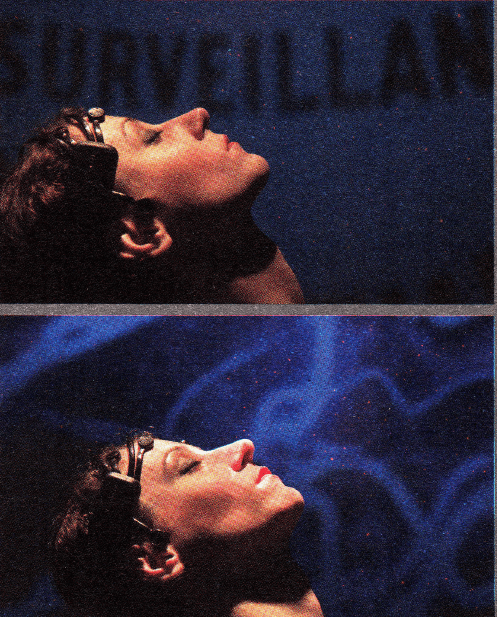Artist Statement
Performance at the CMC Gallery 360 ISEA2016 Exhibition: Interactive immersive brain opera, 2016, 30’00’’
“Noor is a fully immersive brain opera in 360-degree theatre, where a performer launches video, a sonic environment, and a libretto through her brain activity. The world premier was at ISEA2016 Hong Kong on May 18th, with a second run at the Microwave Festival in Hong Kong on May 27th” _emotiv.com/blog/noor-brain-opera-ellen-pearlman
“Noor” (which translates as ‘light’ in arabic) is a brain opera that asks, though metaphor, analogy, sound, text, light, movement, brain sensors and audience interaction with an ‘actor’ wearing an emotiv eeg brainwave headset just one simple question – “is there a place in human consciousness where surveillance cannot go?” Noor is an original ‘brain opera’. Though artists have been working with eegs producing musical events since the 1960s and 1970s, this is a full a full audio visual brain opera. Using an eeg enabled headset, the performer’s emotional states will, at various times, launch digital databanks of video, audio and a libretto while simultaneously displaying the performer’s brainwaves live-time for audience viewing.
Story. Noor is loosely based on the true story of noor inayat khan, a russian born, european raised sufi muslim princess whose father hazrat inayat khan brought sufism to the west. During WW II noor became a covert wireless operator for british intelligence by parachuting deep inside occupied vichy ruled france. For a period of three months noor (code name “nora”) was the only communications link transmitting critical information back to the allies. Caught by the gestapo, who were unable to break her to find out any information about her transmission cell, noor was shot inside the infamous dachau prison shortly before the end of the war. Noor will be used as metaphor to work with issues of surveillance, privacy and faith.
Technology. Using an emotiv headset and max/ msp, a databank of images, sounds and a libretto is calibrated to launch according to different emotional states of the ‘actor’. Those states and databases are keyed to the following mental states:
1. Relaxation
2. Engagement (attention)
3. Interest (enjoyment)
4. Stress
5. A fifth screen displays the ‘actor’s live-time brainwaves
Interactive Components – A Continuous, LiveTime Feedback Loop. The performer moves through the audience. The audience either stands, or sits depending on the venue. The spoken word libretto based on the life of Noor is heard along with the sonic environment. The performer’s brainwaves are displayed live-time for the audience to see as they interact with the performer, and the story. As the performer’s emotional states change, different videos, audios, and parts of the libretto are triggered on four different screens. This in turn changes the performer’s emotional state, which changes the mood and responses of the audience. Only the screen displaying the performer’s brainwaves will be active all the time. The other four emotional states will cause the displayed images and sound to ebb and flow, depending on the live-time interaction between the audience and the performer. The fifth screen will display the performer’s brainwaves live time. “Though artists have been experimenting with the human brain since the 1960s and 1970s, new technologies, research and methods about the brain being developed through global government initiatives in the coming decades raises real concerns over issues of privacy, surveillance, autonomy and consciousness. Do our brainwaves contain the essence of who we are and what we think? In the future how will our personal neurobiological data be used for security identification, thought reeducation, manipulating memory, and personal ‘brain fingerprinting’? If our cognitive process can be monitored and harvested, how do we prepare for this new frontier? ‘Noor (which translates as ‘light’ in Arabic) A Brain Opera’ uses the true story of Noor Inayat Khan, her faith, capture and murder by the Gestapo during World War II as a metaphor of the theatre of war to the theatre of surveillance in a live-time immersive, interactive performance triggered by brainwaves. Being able to view someone’s brainwaves during the performance serves as metaphor for the perfect storm brewing of potentially invasive and identifiable tools of cognitive analysis. These methods and techniques will potentially track, categorize, manipulate and surveil the human brain. The opera raises, but does not answer a simple question – ‘Is There A Place In Human Consciousness Where Surveillance Cannot Go?’
Ellen Pearlman: Director, Videographer, Saba Arat: Performer, Taras Mashtalir: Sonic artist, William Wong: Technical director, Tommy Martinez: Programmer, Natalia Fedorova: Librettist, David Leung: Choreographer, Vincent Mak: Videographer

- Ellen Pearlman is a New York, USA, based artist, writer, curator and critic is a faculty member of Parsons/New School MFADT and Co-Director of the ThoughtWorks Arts Residency. epmexico.wix.com/ellen_pearlman
Full text (PDF): p. 219-221